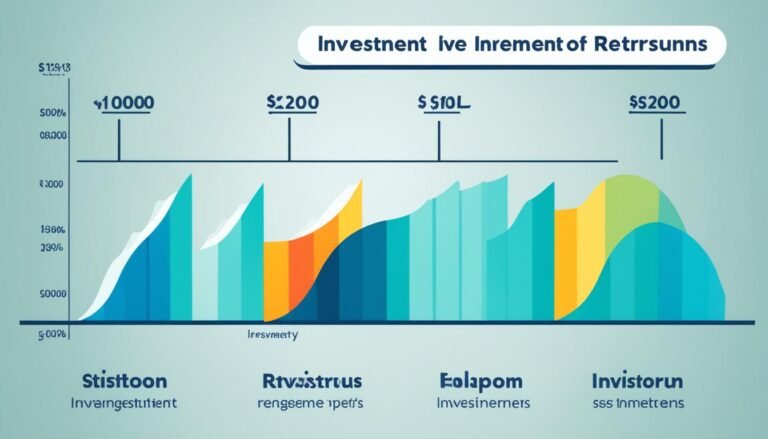Peer-to-Peer Lending Platforms: Transforming Personal Finance
Did you know that the global peer-to-peer lending market is projected to reach a staggering $1.35 trillion by 2025? This unprecedented growth showcases the significant impact of peer-to-peer lending platforms on the personal finance landscape.
Peer-to-peer lending, also known as P2P lending, has emerged as a disruptive force in the financial industry, revolutionizing the way individuals and businesses access credit. These online lending services offer innovative solutions that empower borrowers and provide new investment opportunities for lenders.
By leveraging financial technology, P2P lending platforms have transformed the traditional lending model. They connect borrowers directly with lenders, eliminating the need for intermediary banks and offering alternative finance solutions. This shift has made borrowing more accessible and affordable, enabling economic empowerment through lending.
Key Takeaways:
- Global peer-to-peer lending market projected to reach $1.35 trillion by 2025
- P2P lending revolutionizes personal finance by connecting borrowers and lenders directly
- Online lending platforms offer alternative finance solutions and investment opportunities
- P2P lending makes credit more accessible and affordable, empowering individuals and businesses
- The growth of P2P lending is driven by technological innovations and risk management strategies
The Growth of P2P Platforms
P2P lending gained momentum as the internet became more ubiquitous and public confidence in traditional financial institutions dwindled. Venture capital fueled the expansion of P2P lending, leading to the branching out of platforms into various credit applications such as consumer loans, business funding, and student loan refinancing.
Platforms like LendingClub and Funding Circle solidified their presence in the market, attracting tech-friendly investors and borrowers who valued the convenience and transparency offered by P2P platforms.
The sector saw exponential growth and geographical expansion, catering to a wider audience with diverse credit needs. P2P lending became a viable alternative for individuals and businesses seeking funding beyond traditional bank loans. The appeal of P2P lending lies in its accessibility, streamlined application processes, and competitive interest rates.
P2P platforms offer a marketplace where borrowers and lenders can connect directly, eliminating the need for intermediaries. This direct connection reduces costs and allows for a more personalized lending experience. Additionally, P2P lending platforms employ various risk assessment techniques, including comprehensive credit assessments and data-driven underwriting, ensuring responsible lending practices.
The growth of P2P lending platforms has been driven by their ability to fill gaps in the credit market and address the evolving needs of borrowers. Whether it’s funding a personal project, expanding a business, or refinancing student loans, P2P lending offers a range of options for individuals and businesses alike. The success of platforms like LendingClub and Funding Circle has inspired the emergence of numerous other P2P lending platforms, increasing competition and providing borrowers with even more choices.
As P2P lending continues to gain traction, it is expected to play a significant role in shaping the future of personal finance. The transparency, convenience, and flexibility offered by P2P lending platforms make them an attractive option for borrowers and lenders alike. With ongoing technological advancements and evolving regulatory frameworks, the growth of P2P lending shows no signs of slowing down.
Technological Innovations and Risk Management
The growth of P2P lending has been fueled by technological innovations and the effective implementation of risk management strategies. P2P platforms have harnessed the power of big data analytics and advanced algorithms to revolutionize the underwriting process, going beyond traditional credit scores and offering more comprehensive credit assessments. This data-driven underwriting approach ensures a better understanding of borrowers’ creditworthiness and reduces the risk of default.
Furthermore, P2P lending platforms have adopted various risk mitigation measures to protect investors and ensure a diversified loan portfolio. Loan diversification spreads the risk by dividing investments across multiple loans, minimizing the impact of default on individual investors. Fractional investing allows investors to spread their investments across multiple loans, further reducing risk exposure.
“Data-driven underwriting and risk mitigation measures have played a crucial role in enhancing the resilience and efficiency of P2P lending platforms.”
Investor protections are also an integral part of P2P lending platforms. Reserve funds are set aside by platforms to cover potential loan defaults, providing an additional layer of protection for investors. Buyback guarantees ensure that investors can recoup their investments in case of borrower default. These investor protection mechanisms enhance the overall trust and confidence in the P2P lending ecosystem.
In recent years, blockchain technology has emerged as a potential game-changer in P2P lending. Through the utilization of smart contracts and decentralized ledgers, blockchain promises increased transparency, streamlined contract execution, automated compliance, and reduced operational costs. Its implementation in P2P lending enhances security and trust, benefiting both borrowers and investors.
To ensure the integrity of the P2P lending industry and protect the interests of all stakeholders, regulatory frameworks have been put in place. These frameworks provide guidelines for platform operations, risk management protocols, and investor protection standards. Striking a balance between innovation and regulation is crucial for the sustainable growth of the P2P lending sector.
Key Takeaways:
- P2P lending platforms employ data-driven underwriting and risk mitigation strategies to assess creditworthiness and minimize default risk.
- Loan diversification and fractional investing enable investors to spread their investments and reduce exposure to individual loans.
- Investor protections like reserve funds and buyback guarantees provide additional security for investors.
- Blockchain technology offers transparency, efficiency, and enhanced security in P2P lending.
- Regulatory frameworks ensure the stability and trustworthiness of the P2P lending industry.
The Current State of P2P Lending
P2P lending has now become a mature and significant component of the fintech ecosystem. While personal loans continue to be a mainstay, platforms have also diversified their offerings to cater to a wider range of investment interests and borrowing needs. Let’s explore some of the key segments within the P2P lending space:
1. Personal Loans:
Personal loans remain a popular category within P2P lending, allowing individuals to borrow money for various purposes, such as debt consolidation, home improvement, or education expenses.
2. Real Estate Crowdfunding:
Real estate crowdfunding platforms like Fundrise and Property Partner have brought real estate investing within reach for individual investors. By pooling funds, investors can participate in lucrative property projects and earn returns.
3. Impact Investing:
Impact investing platforms, such as Kiva, provide a unique opportunity for investors to align their investments with positive social and environmental outcomes. These platforms connect borrowers with impactful projects, empowering investors to make a difference.
4. Specialized Business Lending:
P2P lending platforms have also stepped in to meet the credit needs of small businesses and startups that may struggle to secure loans from traditional banks. By providing specialized business lending, such platforms contribute to fostering entrepreneurship and economic growth.
5. Institutional Investor Presence:
As P2P lending has gained traction and proven its viability, institutional investors have increasingly entered the market. Their presence not only brings additional capital but also lends credibility to the sector, further solidifying P2P lending as a mainstream investment option.
With these developments, P2P lending has evolved from its early days as a disruptor to becoming a reliable alternative for borrowers and a profitable avenue for investors. The industry’s expansion into various niches reflects its growing maturity and adaptability to meet the changing needs of the financial landscape.
Future Trends and Predictions
The future of P2P lending is poised for remarkable growth, driven by global economic shifts, technological advancements, and evolving regulations. This dynamic landscape presents numerous opportunities for both borrowers and investors.
In particular, emerging markets hold significant potential for P2P lending expansion. These markets offer diverse borrower options and allow P2P platforms to reach a wider investor base, fueling global growth opportunities.
The integration of Artificial Intelligence (AI) into credit analysis is set to revolutionize the P2P lending industry. AI-powered algorithms will enable more sophisticated credit assessments, providing lenders with comprehensive risk evaluation and borrowers with tailored financial offerings.
In addition, strategic partnerships between P2P platforms and traditional banks are likely to become more prevalent. These collaborations blur the lines between the two sectors and facilitate the sharing of expertise, resources, and customer bases, further driving the evolution of the lending landscape.
Transparency will play a pivotal role in differentiating P2P lending platforms. To instill investor confidence, platforms will need to prioritize clear risk disclosures, showcase strong track records, and ensure robust borrower protection measures.
Key Predictions:
- Emerging markets will drive global P2P lending growth, providing opportunities for both borrowers and investors.
- AI-powered credit analysis will revolutionize risk evaluation, tailoring financial offerings for borrowers and driving lender confidence.
- Strategic partnerships between P2P platforms and traditional banks will reshape the lending landscape, fostering collaboration and innovation.
- Transparency will be a critical differentiator, with platforms focusing on clear risk disclosures, strong track records, and borrower protection.
“The future of P2P lending lies in its ability to adapt to changing market dynamics, embrace cutting-edge technologies, and prioritize transparency to meet the evolving needs of borrowers and investors.”
Conclusion
Peer-to-peer lending has transformed the financial landscape, offering borrowers a wide range of choices and opening up fresh opportunities for investors. The direct connections facilitated by P2P lending platforms, coupled with technological advancements, have propelled this alternative form of financing to its current level of acceptance and popularity.
However, for P2P lending to continue thriving, it must navigate the ever-evolving regulatory landscape, embrace further technological innovations, and prioritize the trust and satisfaction of both borrowers and investors. Thorough research and staying informed will be paramount for individuals interested in P2P lending, as the landscape continues to evolve and shape the accessibility of credit and investment management.
The impact of P2P lending has been significant, fueling a shift in the traditional financial landscape and providing a much-needed alternative to conventional banking. As the sector evolves, it has the potential to further democratize financial services, empowering individuals and businesses in ways previously unimaginable.
The financial landscape transformation brought about by P2P lending serves as a testament to the power of innovation and the ability of emerging technologies to disrupt established systems. Peer-to-peer lending has not only expanded access to credit but has also revolutionized investment opportunities, forging a path towards a more inclusive and connected financial ecosystem.
FAQ
What are peer-to-peer lending platforms?
Peer-to-peer lending platforms are online platforms that connect borrowers directly with lenders, allowing individuals and businesses to borrow money outside of traditional banking institutions.
How do peer-to-peer lending platforms work?
Peer-to-peer lending platforms enable borrowers to create loan requests, while lenders can browse through loan listings and choose which loans to fund. The platforms facilitate the loan disbursement and collection of payments, providing a seamless borrowing and lending experience.
What are the benefits of peer-to-peer lending?
Peer-to-peer lending offers several benefits such as easier access to credit for borrowers, potentially lower interest rates compared to traditional loans, and the opportunity for lenders to earn higher returns on their investments.
Are there any risks involved in peer-to-peer lending?
While peer-to-peer lending can offer attractive investment opportunities, there are risks involved, including the possibility of default by borrowers and the fluctuation of returns. It is important for investors to carefully assess the creditworthiness of borrowers and diversify their investment portfolios.
Can anyone borrow or lend on peer-to-peer lending platforms?
Each platform may have its own eligibility criteria for borrowers and lenders. Generally, borrowers need to meet certain credit requirements, while lenders may need to meet minimum investment thresholds. It is best to check the specific requirements of each platform.
How do peer-to-peer lending platforms ensure the safety of transactions?
Peer-to-peer lending platforms employ various risk management strategies to protect both borrowers and lenders. These strategies may include loan diversification, advanced credit assessments, investor protection funds, and the use of blockchain technology for secure transactions.
Are peer-to-peer loans regulated?
The regulatory landscape for peer-to-peer lending varies by country. Many jurisdictions have implemented regulations to protect investors and borrowers, such as imposing capital requirements on platforms and enforcing transparency and disclosure standards. It is important to understand the regulatory environment in your specific location.
Can institutional investors participate in peer-to-peer lending?
Yes, many peer-to-peer lending platforms now allow institutional investors to participate alongside individual investors. This participation enhances the diversification and liquidity of the platforms, opening up more investment opportunities.
Can peer-to-peer lending platforms be used for business financing?
Absolutely. Many peer-to-peer lending platforms offer specialized business lending services, providing entrepreneurs and small businesses with an alternative source of financing to support their growth and expansion.
What is the future of peer-to-peer lending?
The future of peer-to-peer lending looks promising, with the sector expected to continue evolving and expanding. Advancements in technology, such as artificial intelligence, will further enhance credit assessment and portfolio management. Strategic partnerships between peer-to-peer lending platforms and traditional banks may also become more prevalent, creating new opportunities for borrowers and investors.
Source Links
- https://www.quiltt.io/blog/the-disruptive-rise-of-peer-to-peer-lending-a-revolutionary-shift-in-finance
- https://www.linkedin.com/pulse/evolution-peer-to-peer-lending-platforms-empowering-borrowers-fwefc?trk=article-ssr-frontend-pulse_more-articles_related-content-card
- https://medium.com/@garypryor/the-new-age-of-consumer-lending-innovative-practices-transforming-personal-finance-2969db920a04








